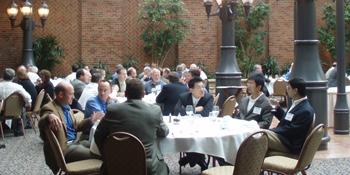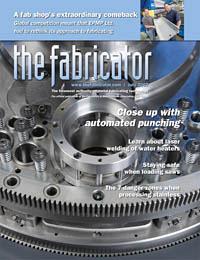Contributing editor
- FMA
- The Fabricator
- FABTECH
- Canadian Metalworking
Categories
- Additive Manufacturing
- Aluminum Welding
- Arc Welding
- Assembly and Joining
- Automation and Robotics
- Bending and Forming
- Consumables
- Cutting and Weld Prep
- Electric Vehicles
- En Español
- Finishing
- Hydroforming
- Laser Cutting
- Laser Welding
- Machining
- Manufacturing Software
- Materials Handling
- Metals/Materials
- Oxyfuel Cutting
- Plasma Cutting
- Power Tools
- Punching and Other Holemaking
- Roll Forming
- Safety
- Sawing
- Shearing
- Shop Management
- Testing and Measuring
- Tube and Pipe Fabrication
- Tube and Pipe Production
- Waterjet Cutting
Industry Directory
Webcasts
Podcasts
FAB 40
Advertise
Subscribe
Account Login
Search
Lifestyle trends expand use of lasers, ALAW presenters say
- By Kate Bachman
- July 10, 2007
- Article
- Laser Welding
When the Fabricators & Manufacturers Association, Intl. (FMA), Rockford, Ill., and the Laser Institute of America (LIA), Orlando, Fla., announced in April 2006 that they had purchased the Automotive Laser Application Workshop (ALAW), FMA President and CEO Gerald Shankel explained FMA's objective for its role in the acquisition.
"This will empower the Fabricators & Manufacturers Association to provide greater access to cutting-edge laser technology to our 1,500 members and 160,000 subscribers."
The new direction materialized with an entire day devoted to fabricators with presentations on fabricating with lasers and safety. Fabricators Day at ALAW 2007 was held April 17 to 19, in Plymouth, Mich. (see "Making money with lasers" by Executive Editor Dan Davis, May, p. 13).
Societal Demands Drive Laser Technology
Two days of the conference focused on laser technology in automotive research and applications and were geared mostly to manufacturing, production, product design, and R&D engineers.
Societal demands driving greater dependence on laser technology are energy and environmental concerns, as well as customization, said presenter Reinhart Poprawe, the Fraunhofer Institut Lasertechnik.
The demand for customization and diversity requires the high-speed capabilities and flexibility of laser processing, Poprawe said. Laser surface technologies will play a greater role in the future in forming materials and assemblies, such as laser welded blanks, to improve fuel efficiency. Laser optics will play a larger role in inspection and quality assurance detection, he said. In addition, Poprawe predicted that diode solid-state (disk and fiber) laser welding will emerge as the dominant form of welding in automotive applications to meet cost-reduction and flexibility demands.
Customer demand for customization may drive some unique, out-of-the-box designs that could create new manufacturing approaches requiring laser technology, said Klaus Loeffler, TRUMPF Laser Technology Center. The aging population may usher in what he called "the Silver Age," requiring auto designs that are easier to open and get into, with seats that swivel out, for example. Car designs will change from today's unibody to tubular space frames, achievable with laser welding, or board frames, flattened bodies over which assembled body shells will be positioned. This will require single-sided joining and laser trimming, he predicted.
Some of the more fanciful designs Loeffler proposed include cars with built-in rear-facing, "park benchlike" seats; expandability to accommodate more or fewer passengers; and kiddie cars as a new vehicle market. In addition, he predicted environmental and safety concerns will expand the need for laser cutting and welding to achieve weight reduction with high-performance materials, fewer components, a larger mix of materials per vehicle, and alternative propelling systems such as fuel cells and hybrid engines.
Laser Welding, Brazing at Forefront of Laser Growth
Presentations on applications for laser brazing, remote laser welding, and solid-state (disk and fiber) lasers dominated the days' presentations. Examples were offered of laser welding and brazing being implemented increasingly in automakers' plants and by their suppliers.
GM Technical Center's Michael Poss highlighted the problem of zinc evaporation causing visual discontinuities—pits, pores, and skips—in laser-brazed joints on galvanized materials using real-time X-ray visualization techniques. Typical laser-brazed automotive applications include liftgates, decklids, and roof attachments. Poss warned that the costs of repairing visual discontinuities can counter the benefits of laser brazing—smoothness, no spatter, low heat distortion, no need for weld grinding, and high speed. The study concluded that weld visual discontinuities are caused by incorrect braze parameters such as laser power, travel speed, work angle, and wire feed speed.
In the last five years, solid-state fiber lasers have experienced a rapid growth in power, said Randolph Paura, of Dynamic Laser Solutions Inc. Power increases, coupled with improvements to fiber laser beam quality, have made possible new processing opportunities for fiber laser cutting as well as welding, he said.
The flexibility of laser welding provides many opportunities for cost and mass savings in autobody components such as exposed body sides, curvilinear and straight liftgates, pillars, and sills, said Steve Prue, Laser Welding Intl. Laser welding also provides opportunities to construct sills, bumpers, and pillars from tubular components, he said.
Automakers may save money by using laser welding to join dissimilar materials in power trains, said Jens Standfuss, Fraunhofer Institut Lasertechnik. First, however, an analysis of cold-crack risks in the weld must be done to determine which laser welding strategy must be adapted to prevent cracks. Successful strategies include using filler metal with laser welding; using induction welding with laser welding; creating a very narrow weld via fiber laser welding; and by altering the chemistry of the weld with laser welding alone.
Integrating weld inspection systems permits the inspection of weld edge position before and after the weld; seam profile; and seam surface for texture, pores, and microcracks, according to Marcel van Schaik, Soutec Soudronic. GM is using a weld inspection system to monitor laser-brazed roof seams on its Cadillac CTC®, van Schaik said.
Wire feed laser welding is commonly applied when autogenous (no wire) welding produces unacceptable welds, such as gaps, cracking, weld toughness, and material incompatibility, said D. Mark Douglass, Preco Laser Systems LLC.
Remote laser welding continues to make great strides because of its ability to move quickly between welds and to reach otherwise inaccessible areas, according to presenters. Remote laser welding achieves beam positioning via mirrors, or scanners, said Dale Sabo, SCANLAB America.
Challenges for remote laser welding include the necessity for high beam quality; synchronization with a robot (required for Nd:YAG and CO2lasers); and the need for special tooling, Sabo said. High scanner dynamics enable fast positioning on-the-fly, rapid pattern changes, and weld strategy variations. CO2remote welding systems usually must be stationary, while diode solid-state disk or fiber lasers can be mobile and set up without a robot.
As beam quality improves, longer focal lengths and smaller spots will be achieved, while system size and cost will be reduced, Sabo predicted.
Automakers' Current Applications
Automakers Volkswagen, Nissan, Daimler, and China FAW shared examples of where and how they apply laser welding and brazing in their manufacturing operations.
Volkswagen implemented laser brazing in 1997, Torsten Jaeckel said. The triplane-shaped trunk lid design could not be stamped as one piece; therefore, two stamped parts had to be joined to create the assembly. VW chose laser brazing to accomplish the task. Laser brazing was chosen because it minimizes heat distortion and creates a smooth, barely visible seam, Jaeckel said. The approach was so successful, the company expanded laser brazing's use to other assemblies, and it plans to expand its use to join roof seams, side panel seams, and trunk lid seams.
Daimler showcased its most recent use of laser brazing and laser welding in the 2007 Mercedes-Benz C-Class® (W204): It laser-brazes three components of the trunk lid; "laser-fixes" doors; and remotely laser-welds doors, inner side walls, and rear centers, Bertold Hopf said. Altogether, it laser-joins 61⁄2 meters of seams. Earlier laser applications for Mercedes-Benz vehicles include laser welding the roof to the side wall and base to the floor; laser-brazing the side wall of the 2006 Sprinter BR906®—30 meters of seams; and hybrid laser welding aluminum doors, laser-fixed doors and fenders, and roof rails—15 meters in all—on the 2005 S-class® (W221).
Nissan uses laser welding to manufacture tailor welded blanks and to achieve one-sided body welding of roofs, sills, and seat backs, according to Takashi Kashikuma. It also employs remote welding to join hood and trunk lids. Continuous laser welding is used to achieve high torsion stiffness and weight reduction. For example, 4.7 meters of continuous welds in the sill, shelf, and seat back of Nissan's G35® contribute stiffness, Kashikuma said. Remote welding helps the company achieve cost reduction by stage integration and by cutting labor costs, Kashikuma said. For example, by converting from spot welding to remote welding of horseshoe-shaped "ring welds" on its trunk lid, the company reduced the number of welds from 102 to 22. Nissan also uses a 100 percent inline monitoring system to inspect the welds.
China FAW manufactures its own brand model, Brilliance Auto Junjie®, as well as the Audi A4®, A6®, VW Golf 4®, Passat®, Bora®, and Ford Focus®, in a joint venture, said Dr. Yao Yuan. The automaker laser-welds water pump gears on its JMC; laser-hardens engine cylinders in the BJC; laser-alloys piston grooves; laser-hardens engine crankshafts; and laser-welds the roof to the car body of all of the VW models it makes. It also uses lasers to cut and mark. FAW produced 7 million vehicles in 2006.
The joint acquisition of ALAW brings together the laser technology and safety standards expertise of LIA and the metal fabricating industry and educational strengths and depth of FMA to produce an unparalleled educational laser technology conference beneficial to both organizations' members and readers.
Fabricators interested in attending next year's ALAW should mark their calendars for May 13-15, 2008, and call 815-399-8775.
About the Author

Kate Bachman
815-381-1302
Kate Bachman is a contributing editor for The FABRICATOR editor. Bachman has more than 20 years of experience as a writer and editor in the manufacturing and other industries.
subscribe now

The Fabricator is North America's leading magazine for the metal forming and fabricating industry. The magazine delivers the news, technical articles, and case histories that enable fabricators to do their jobs more efficiently. The Fabricator has served the industry since 1970.
start your free subscription- Stay connected from anywhere

Easily access valuable industry resources now with full access to the digital edition of The Fabricator.

Easily access valuable industry resources now with full access to the digital edition of The Welder.

Easily access valuable industry resources now with full access to the digital edition of The Tube and Pipe Journal.
- Podcasting
- Podcast:
- The Fabricator Podcast
- Published:
- 04/16/2024
- Running Time:
- 63:29
In this episode of The Fabricator Podcast, Caleb Chamberlain, co-founder and CEO of OSH Cut, discusses his company’s...
- Industry Events
16th Annual Safety Conference
- April 30 - May 1, 2024
- Elgin,
Pipe and Tube Conference
- May 21 - 22, 2024
- Omaha, NE
World-Class Roll Forming Workshop
- June 5 - 6, 2024
- Louisville, KY
Advanced Laser Application Workshop
- June 25 - 27, 2024
- Novi, MI
































